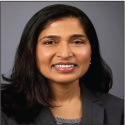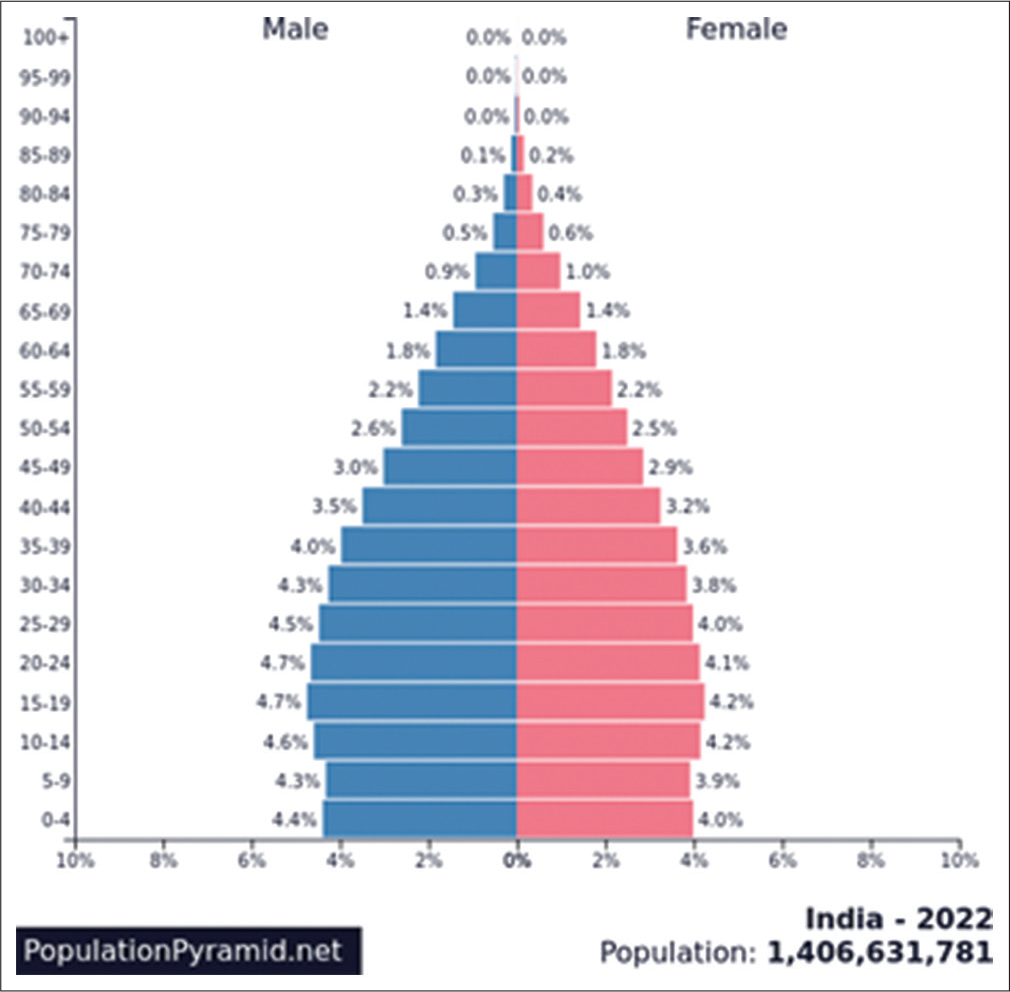Translate this page into:
India’s demographic transition and burden of oral cancer

*Corresponding author: Radhika Chigurupati, Associate Professor, Department of Oral and Maxillofacial Surgery, Boston University Medical Campus, Henry M. Goldman School of Dental Medicine, Boston, United States. chigurupati. radhikachigurupati@gmail.com
-
Received: ,
Accepted: ,
How to cite this article: Chigurupati R. India’s demographic transition and burden of oral cancer. J Acad Dent Educ 2022;8:35-6.
Last month, the world population hit a new record of 8 billion, with India (1.42 billion) and China (1.43 billion) accounting for a third of the global population. According to the United Nations Population Fund (UNFPA), India is set to surpass China to become the most populous country in the year 2023. The Worldometer extrapolation of the United Nations data shows that the current population of India is 1,412,755,175 which is about 17.7% of the total global population.[1] The median age of the population is 28.4 years. While Indians and rest of the world are talking about the demographic change and the benefits of India’s growing young population and its impact on the economy, we have to be cautiously optimistic about this demographic dividend.
The population pyramid of India right now looks as shown in [Figure 1] below. The pyramid shows that currently, 40% of India’s population is under the age of 40 years. “As India invests in its younger people, it needs to make plans for a demographic transition to take better care of a greater proportion of older people in the future,” the UNFPA said in comments shared with Reuters recently.[2] This pyramid shape is going to gradually change over the next 18–20 years as the number of children per woman (Total Fertility Rate) falls below 2.1. The falling fertility rates in some regions can be attributed to the family planning policies, increasing use of contraception, better literacy, and more educated young women. If the growth rate of India’s population decreases as predicted by the year 2040, then we will see an increasing number of older adults. This comes with an increase in burden of chronic diseases such as cancer, diabetes, cardiovascular and pulmonary disorders, dementia, and Alzheimer’s disease [Figure 1].

- Source: populationPyramid.net.
Around the same time as the release of the above population report by Reuters, in Mid-November, the International Association for Research in Cancer (IARC) published their report on oral cancer prevention. They highlighted the strategies that have been proven in the past and can be implemented in resource-limited settings.[3] The IARC report confirms again that there is a reduction in risk of oral cancer among former smokers with increasing the duration of smoking cessation. In other words, it is never too late to quit smoking. The report highlights that there is 35% reduction in incidence of oral cancer among former smokers within 4 years of cessation as compared to current smokers. This risk of oral cancer decreases much more (odds ratio 0.19–95% CI: 0.15–0.24) after 20 years or more of smoking cessation, which is similar to the risk in never-smokers. They also stated that the incidence of leukoplakia decreased by 85% after cessation of bidi smoking.[3]
As health-care providers, we need to pay attention very closely, and more importantly, understand two concepts as we think about the future of the Indian population (1) Demographic dividend and (2) Demographic transition. We know that population growth and economic growth are dependent on several factors including the changing age structure of the population. According to the population economics researcher Mr. Utsav Kumar, demographic transition is the shift from high mortality and high fertility rates to low mortality and low fertility rates. In India, the states of BIhar MAdhya Pradesh, RAjasthan, and Uttar Pradesh (Collectively known as BIMARU) – because of their lack of economic growth and high population growth rates), Assam, Haryana, and Orissa will be slow to make this transition from high-birth and high-death rates to low-birth and low-death rates.[4]
Hence, currently, we have a large number of young males and females who are competing for jobs in a growing economy or who may be unemployed if there are in the BIMARU states. The youth are very impressionable and are susceptible to habits of tobacco smoking, and at risk of use of alcohol, areca nut and, recreational products such as Gutka, Tombol, and Paan with tobacco. What can we do as oral health providers in a country that carries the highest burden of oral and oropharyngeal cancers compared to other regions of the world? A lot has been done to increase the awareness by public health dentists and healthcare workers across the country; but more focused efforts paying attention to the demographic transition are essential to see an impact or change in the burden of disease.
Kulothungan et al. 2022 have identified the regions in India with the highest burden of cancer. The recently published estimates based on the data from National Cancer Registry Program in India, it shows that the North (2408 *DALYs AMI/100, 000) and North-east (2177 DALYs AMI/100, 000) regions account for the majority of the burden. It is expected that the overall burden for cancer in India will increase from 26.7 million DALYS* in 2021 to 29.8 million in 2025. Among men, the aerodigestive tract cancers (Lung - 10.6%, mouth - 5.7% esophagus – 5.8%, and stomach – 5.2%) carry the highest burden of all cancers and, among women, breast, lung, cervical, and uterine cancers carry the highest burden.[5]
What can we do to achieve the goals to decrease the burden of oral cancer? Now is the time to act to enforce laws related to tobacco and alcohol use (primary prevention) and increase reproducible methods of oral cancer screening by clinical examination by trained public health dentists and Accredited Social Health Activists (ASHA) workers (secondary prevention), use telemedicine resources to improve diagnosis of oral cancer at early stages. Suggestions and efforts have been made to improve the oral health literacy of the population in BIMARU states and to increase use of mobile technology and social media to assist ASHA workers with oral cancer screening at Primary Health Centers and rural and urban Dental clinics.
*DALYS: Disability adjusted life years; AMI: Adjusted mortality to incidence ratio.
References
- Available from: https://www.worldometers.info/world-population/india-population [Last accessed on 2022 Nov 29]
- Reuters. Available from: https://www.reuters.com/world/india/indias-population-growth-slows-world-reaches-8-billion-2022-11-15 [Last accessed on 2022 Nov 29]
- [Google Scholar]
- IARC perspective on oral cancer prevention N. Engl J Med. 2022;387:1999-2005.
- [CrossRef] [PubMed] [Google Scholar]
- India's Demographic Transition: Boon or Bane? A State-Level Perspective. Available from: https://www.ssrn.com/abstract=1675278 [Last accessed on 2010 Sep 02]
- [Google Scholar]
- Burden of cancers in India-estimates of cancer crude incidence, Ylls, Ylds and Dalys for 2021 and 2025 based on national cancer Registry program. BMC Cancer. 2022;22:527.
- [CrossRef] [PubMed] [Google Scholar]





